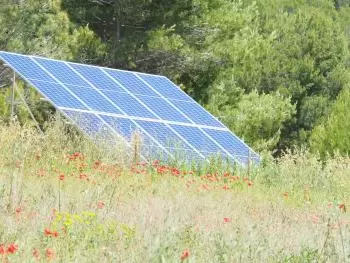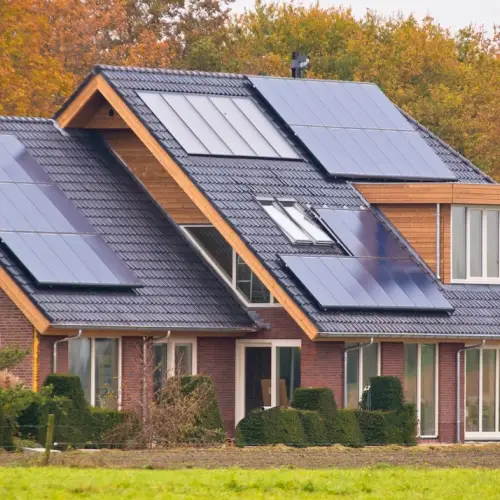
Thermal solar panels and photovoltaic solar panels are two technologies based on the use of solar energy. However, their operation, applications and performance are different.
Type of energy obtained
The main difference between both systems lies in the type of energy they generate and how they use it:
- Photovoltaic solar panels: convert solar radiation into electrical energy through a photochemical process in their solar cells. This electricity can be used immediately or stored in batteries for later use.
- Thermal solar panels: capture solar energy in the form of heat through collectors, transferring it to a heat-carrying fluid. This heat can be used directly to heat water, for heating or, in more advanced systems, to generate electricity using steam turbines.
Differences in economic cost
Cost of solar thermal panels
 Solar thermal panels generally have a lower initial cost compared to photovoltaic panels due to the simplicity of the technology.
Solar thermal panels generally have a lower initial cost compared to photovoltaic panels due to the simplicity of the technology.
They are mainly made of materials such as copper, aluminium and glass, which are cheaper than the semiconductors used in photovoltaics. In addition, solar thermal systems require fewer electronic components and do not need inverters, which reduces the overall cost of the installation.
For a typical domestic installation, prices typically range from €2,500 to €6,000, depending on the size of the system and heat collection capacity. Smaller systems, which only provide water heating, tend to be at the lower end, while those that also include space heating can be at the higher end.
Maintenance costs are low as these systems have a useful life of many years without the need for significant repairs.
Cost of photovoltaic solar panels
In comparison, photovoltaic panels are more expensive due to the complexity of the technology of converting solar energy into electricity.
They are made primarily of silicon solar cells, which requires a more advanced manufacturing process, and they also require inverters and other electronic components to convert the power to alternating current (AC), which increases the overall installation price.
For a home installation of photovoltaic panels, the cost typically ranges from €4,000 to €9,000, depending on the capacity of the system, which is generally between 3 and 5 kW for an average-sized home. This cost includes the panels, the inverter, the mounting system and the installation. Although costs have decreased in recent years due to technological advances, photovoltaic systems are still more expensive than thermal ones.
However, photovoltaic panels can generate electricity, allowing for greater energy self-sufficiency and potential savings on electricity bills in the long term.
Although maintenance is relatively low, the inverter may need to be replaced after about 10 years.
Energy performance differences
Performance of solar thermal panels
Solar thermal panels are highly efficient at converting solar energy into heat. They are often superior in their performance to photovoltaic panels in terms of capturing and using solar energy directly, especially in water heating or space heating applications.
The conversion efficiency of these systems can exceed 70%, meaning that a large portion of the solar energy they capture is converted into useful heat. This makes them particularly suitable for homes that require hot water or heating, as they do not rely on conversion to electricity, but instead use the heat directly.
Performance of photovoltaic solar panels
 In the case of photovoltaic panels, their performance is focused on the conversion of solar energy into electricity, which has a much lower efficiency compared to thermal panels.
In the case of photovoltaic panels, their performance is focused on the conversion of solar energy into electricity, which has a much lower efficiency compared to thermal panels.
The most efficient photovoltaic panels currently have an efficiency of between 15% and 22%, meaning that a fraction of the sunlight that falls on them is converted into electricity. Although this efficiency is lower, photovoltaic panels can generate electricity even in diffuse light conditions, such as on cloudy days, making them more versatile in a variety of weather conditions.
Energy storage
- Photovoltaic systems can store the electricity generated in batteries for later use.
- Thermal systems store heat in solar accumulators, which retain thermal energy in the form of hot water or special fluids.
Differences in operation
How a photovoltaic solar panel works
Photovoltaic panels are made up of solar cells made of semiconductor materials such as silicon. When sunlight hits these cells, the photons generate a flow of electrons, producing an electric current in direct current (DC), which is then transformed into alternating current (AC) for use in the home or industry.
How a solar thermal panel works
Solar thermal panels use absorbent surfaces to capture solar energy and transfer the heat to a heat-transfer fluid. This fluid can be used to heat hot water, for heating or even to generate steam to drive turbines in solar thermal power plants, producing electricity.
Comparative advantages and disadvantages
| Feature | Photovoltaic | Thermal |
|---|---|---|
| Type of energy | Electric | Thermal |
| Applications | Lighting, electronics, household appliances | Heating, hot water, indirect electricity generation |
| Storage | Batteries | Solar accumulators |
| Initial cost | High | Lower |
| Efficiency | Lower energy conversion | Major in thermal application |
| Maintenance | Low | Requires periodic review |